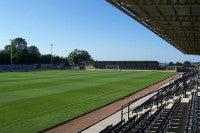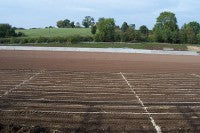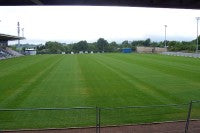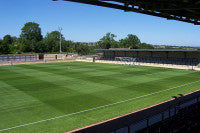New stadium and new challenges
 Its been a very hard but rewarding 10 week close season for me at Forest Green Rovers F C. We start the Nationwide Conference 2006/7 season at our new 5 million pound muiti-purpose stadium.
Its been a very hard but rewarding 10 week close season for me at Forest Green Rovers F C. We start the Nationwide Conference 2006/7 season at our new 5 million pound muiti-purpose stadium.
My first meeting with the M.D. of Pitchcare, Dave Saltman, was at my job interview for the assistant position at the Millennium Stadium in 2004. I was not selected, but his kind and honest assessment of me, made me more determined to pursue a career in sportsturf and particularly into the world of football, so I posted my CV to football clubs. The result was that I joined Forest Green Rovers F C in June 2005.
My role at the club was divided into two roles. One to oversee the conception and construction of the new pitch and two to continue to maintain the old pitch to get though 75 matches and 5 training sessions for its final season. This included the growing in and maintainance of a new school pitch as part of the new stadium land design plan.
I took on the challenges and demands by starting with the 2005/6 pre- season work on the old pitch, the surface was a struggle to maintain efficiently due to the soil pan, a black layer 2 inches below the surface. With the clubs investment in the new stadium I only had a small budget to work with. I embarked on a programme of regular aeration, sand dressing, feeding and mowing including the use of the McMurtry robotic aid Mas 01(this allowed me time to work on the school pitch).
The pitch ended its history this spring with still 65% grass coverage and a final day 2-0 victory to ensure conference football at our new stadium.

Last year with the new pitch designs on paper and the sub soil having been cultivated and stone buried down to 5 inches (125mm) my new stadium pitch preparations started with discussions for a change to the mid October start date that the architect had stated. I aimed for a mid September construction date to catch the warm soil temperatures in early autumn. Once agreed I sent the construction specifications out to final tender.
A trip to Windsor in September aided my decision on what new machinery I needed. The trip was followed by a couple of demonstrations which led to me ordering a New Holland 27hd tractor with turf tyres via T H Whites. It is a light machine and has a good steering angle, with a fixed operating speed system, which is ideal for aeration and feeding at one speed.
For pitch cutting, I opted for the Dennis 34", 5 unit cassette system with a trailed seat. This was basically to save money on buying 5 different machines, as well as reducing handling and weight problems.
I am currently on the look out for a Wiedenmann verti- drain machine to facilitate my aeration programme at the ground.
I also reviewed my suppliers list, bringing in some new suppliers were required to ensure a greater flexibility and value for money.
After a number of chats with sales representatives and fellow groundmen. I decided that Rigby Taylor would be the best for us and with them we designed a fertilising regime that both met the needs of the turf and sat within my budget allowances.
When all the returned tenders for the new pitch construction were in, I spoke to the chairman, giving him my preferred choice of contractor, stating my reasons. White Horse Contractors Ltd were the successful firm and were awarded the contract. They started the construction works towards the end of September.
 Pitch construction summary:
Pitch construction summary:
- 12 lateral drains laid in the existing subsoil. depth of 600mm, 80mm wide topped with 10mm washed gravel.
- Sand slits installed every 2 meters at 90 degrees to the drains, depth of 250mm, 50mm wide, topped with 10mm washed gravel.
- 1350 tonnes of Mansfield sands 70/30 rootzone mixed with existing soils to the depth of 150mm with a fall of 1 in 5 from the centre.
- Seeded with Rigby Taylor R14 ryegrass mix in 3 directions @ 35 grams m2.
- Full pop-up irrigation system installed around the perimeter of the pitch.
October:
With drainage completed, lorry after lorry load of rootzone was arriving. It was a joy to see a final completion ahead of us. Unfortunately with the first inch (25mm) completed, heavy rainfall set in for 2 weeks! . The headaches came as the stockpiles of rootzone started to hold up site works. Whitehorse only managed to complete the rootzone cultivations by mid November.
To avoid damaging the drainage, Whitehorse constructed a path of rootzone down the centre of the pitch and pushed the rest of the root zone towards the edges before the pitch was graded to finished levels.

We had very little germination during the winter months, some of the rootzone on the wings had washed off with the heavier rains. The sub-contractors (Mark Kamalra ) returned to re-level the surface in mid April and overseeded in 3 directions (9 bags of R14). They also used a pre-seed feed of mascot 6-9-6, applying 12 x 20kg bags. With the temperatures still cool it took about 3 weeks until establishment and the first cut
May 3rd:
Pitch preparations could finally begin, with my first priority to promote growth to establish a full sward.
- Light roll with Dennis mower followed by Honda rotary mowing at 45mm dropped to 40mm in 2nd week..
- Fertilising with 12-6-6, 15 x 20kg bags.
18-3-6 to re-establish grass colour and sward once ground had started to dry out. Just as the weather was getting warmer, a week of monsoon rain caused areas of weak growth to become damp and appear red so I applied a liquid feed of
It took until the 2nd week in June for the grasses to establish and fill out to my liking. The good root development allowed
 the plants to retain good even colour even under heat stress. The 35% Action in the R14 seed mix produced the close knit sward with the Greenfair producing a high shoot density.
the plants to retain good even colour even under heat stress. The 35% Action in the R14 seed mix produced the close knit sward with the Greenfair producing a high shoot density.
Establishment was near 100% and growth was non-stop, this was pleasing but hard work to keep on top of and involved many trips to the skip.
- Cylinder mowing @35mm 3 times a week reduced to 30mm height of cut in late June.
- Feeding with Mascot mini granular 12-0-9, Guardian with Activate R18 bags to increase nutrient retention.
- Topping up wings with 10 tons of 70/30 rootzone and re seeding.
- Aeration @ 2 inch centres with solid tines. Careful not to disturb pitch.
- Irrigation on each night during the heatwave to avoid excessive evapotranspiration.
- Set out corners and find centre of goals. Excavate and cement in new aluminium 3D goals, via Edward's Sports.
- 1st mark out with sharp crisp right angles using our new white paint and line marker.
July:
The marathon of games started on July 12th, Swindon ,followed by Sunderland 1st team on the Saturday and Bristol City 2 days after that. This was, followed by Hereford on July 25th (nothing like pressure!) thankfully everything had responded well to the maintenance and the arranged fertiliser plan.
- Mowing every day to maintain a tight sward @29mm in bands
- Aeration repeated as before, 1 week before match.
August and First Game:
 The first full game had arrived. At 8.30am I started with a final mow, followed by a mark out. With the mowing bands and lines in place I put the goals up, attaching the nets and securing them to the ground. My final duty was to walk around the pitch inspecting for any debris while putting the corner flags in. I watched the warm up with a few butterflies in the pit of my stomach. You tend to watch every detail, the run of the ball, how the studs are griping, how the keepers were using their 5 minute crossing session in the goal.
The first full game had arrived. At 8.30am I started with a final mow, followed by a mark out. With the mowing bands and lines in place I put the goals up, attaching the nets and securing them to the ground. My final duty was to walk around the pitch inspecting for any debris while putting the corner flags in. I watched the warm up with a few butterflies in the pit of my stomach. You tend to watch every detail, the run of the ball, how the studs are griping, how the keepers were using their 5 minute crossing session in the goal.
The game began with the same worries, but I needn't have, I walked the pitch at half time to see no major damage. I sat down for the 2nd half with a confident smile thinking the last 10 weeks had been worth the sweat and pain and the stress.
So far all the feedback has been positive, especially from away managers and some praise from my chairman. Now this was praise, cause it don't come out a lot to anyone -trust me!
With my arranged 2 week break for pitch recovery from the pre season games (in case the pitch did not play well.) I am able to perform another verti-drain, some light scarifying and top dressing of a few low levels. I will get another 12-0-9 feeding in as well.
The robotic mower has been set and glides smoothly up and down on the new pitch, maintaining the height of grass at 28mm using its laser beamsed signals. I embrace this technology as it enables me to get on with other important tasks. Being on my own the robotic machine reduces my mowing hours by half, and even allows me some time off.
I have been able to get the surface to a high standard and with the tag of best pre -season pitch in our league now comes a lot of expectation for more of the same this season. I am striving for the perfect pitch because that's the standard I work to. I don't mind putting pressure on myself to get the best results for me, the pitch and the club.
Watch out Football League, here we come!!
